|
|
 |
|
 |
| |
Publisher: Chairman Gong-Ru Lin Editors: Professor
Chao-Hsin Wu, Ms. Hsiao-wen Lin July 15, 2017 |
| |
|
 |
|
Congratulations to GIPO professor Ching-Fuh Lin and professor Sheng-Lung Huang for winning the “2016 Distinguished Research Awards” from the Ministry of Science and Technology, R.O.C.
Congratulations! GIPO professor Chee-Wee Liu receives the title of “Micron Technology Chair Professor” and professor Chi-Kuang Sun receives the title of “AmTRAN Technology Chair Professor”.
Congratulations to GIPO professors Sheng-Lung Huang, Jian-Jang Huang and Chao-Hsin Wu for being awarded the “2017 EECS Academic Contribution Prizes”.
Congratulations to GIPO professor Chao-Hsin Wu for being awarded the “2017 EECS Irving T. Ho Distinguished Young Scholars”.
|
|
 |
|
 |
|
| |
|
 |
|
March “GIPO Colloquium” Highlights
(Compiled by Li-Chi Yao) |
|
|
4:30 pm, March 3 (Fri.), 2017 |
|
Speaker: |
Chin-Lung Ting, Executive Vice President, Innolux Corporation |
|
Topic: |
Observations and introspection on Taiwan’s optoelectronics industry |
| |
Chin-Lung Ting, the executive VP of Innolux Corporation, visited GIPO at the invitation of GIPO professor Lung-Han Peng on March 3 (Fri.). He delivered a speech concerning “Observations and introspection on Taiwan’s optoelectronics industry” at auditorium 101, Barry Lam Hall. His speech was excellent, rich in content, and Mr. Ting interacted very well with students. GIPO teachers and students participated in this event with enthusiasm and benefitted a great deal from it. |
| |
|
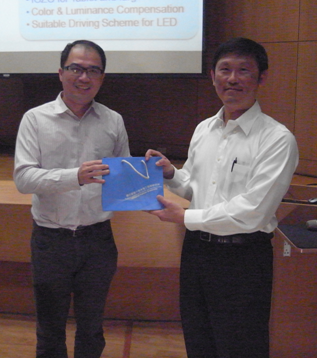 |
|
Chin-Lung Ting, executive VP of Innolux Corporation (right), and GIPO vice chairman, Professor Jian-Jang Huang (left) |
|
|
|
4:30 pm, March 10 (Fri.), 2017 |
|
Speaker: |
Wen-Kuan Yeh, Director General, National Nano Device Laboratories |
|
Topic: |
New Paradigm of Nano Device - From More Moore to More than Moore |
| |
Wen-Kuan Yeh, the Director General of National Nano Device Laboratories, visited GIPO on March 10 (Fri.) and delivered a speech concerning “New Paradigm of Nano Device - From More Moore to More than Moore” at auditorium 101, Barry Lam Hall. His speech was wonderful and informative, and the director interacted well with students. GIPO teachers and students attended the event with enthusiasm and benefitted a great deal. |
| |
|
 |
|
Wen-Kuan Yeh, Director General of National Nano Device Laboratories (right), and GIPO professor Lung-Han Peng (left) |
|
|
|
4:30 pm, March 24 (Fri.), 2017 |
|
Speaker: |
Deng-Fa Tsai, Executive Vice President, GlobalSat Worldcom
Co, Ltd. |
|
Topic: |
Creating new businesses and reforming troubled businesses in a group company |
| |
Deng-Fa Tsai, the executive VP of GlobalSat Worldcom Co, Ltd., visited GIPO on March 24 (Fri.) and delivered a speech concerning “Creating new businesses and reforming troubled businesses in a group company” at auditorium 101, Barry Lam Hall. His speech was splendid and informative, and Mr. Tsai interacted well with students. GIPO teachers and students participated with enthusiasm and learned a great deal. |
| |
|
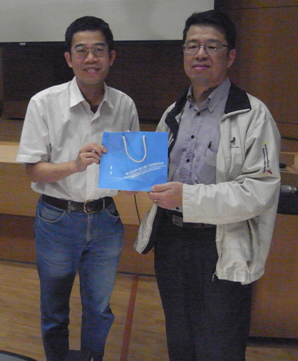 |
|
Deng-Fa Tsai, executive VP of GlobalSat Worldcom Co, Ltd. (right), and GIPO professor Lung-Han Peng (left) |
|
|
Nobel Laureate Lectures on Solid-State Lighting |
|
Place: |
auditorium 101, Barry Lam Hall |
|
1st lecture: |
2:20 pm ~ 3:50 pm, March 22 (Wed.), 2017 |
|
Topic:
|
50 Years of Nitride Optoelectronics |
|
2nd lecture: |
2:20 pm ~ 3:50 pm, March 23 (Thur.), 2017 |
|
Topic:
|
Latest and Future Prospects of Nitride Optoelectronics |
|
Speaker:
|
Shuji Nakamura, Distinguished Chair Professor, GIPO, NTU |
|
|
Professor Shuji Nakamura, has been called “the father of blue light LED”, and is also the 2014 Nobel physics laureate. In the name of science-education promotion and social-service spirit, NTU has especially invited the professor, now teaching at University of California, Santa Barbara, USA, to give us Nobel laureate lectures on LEDs and Laser Diodes in March, 2017. |
|
|
|
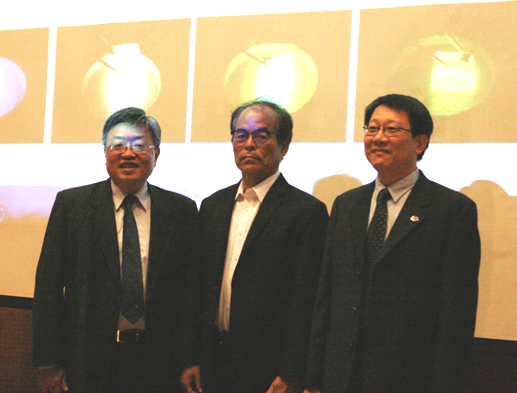 |
|
A group photo of Professor Shuji Nakamura (middle), and Professor Ming-Syan Chen, dean of EECS (left), and Professor Gong-Ru Lin, chairman of GIPO (right) |
|
|
April “GIPO
Colloquium” Highlights
(Compiled by Li-Chi Yao) |
|
Time: |
4:30 pm, April 28 (Fri.), 2017 |
|
Speaker: |
Shangjr Gwo, Director,
National Synchrotron Radiation
Research Center |
|
Topic:
|
Fiat Lux: Advances in Cutting-Edge Light Sources |
|
|
Shangjr Gwo, director of National Synchrotron Radiation Research Center, visited GIPO on April 28 (Fri.) and delivered a speech concerning “Fiat Lux: Advances in Cutting-Edge Light Sources” at auditorium 101, Barry Lam Hall. His speech was marvelous, and the director interacted very well with students. GIPO teachers and students enthusiastically took part in this event and benefitted a lot from it. |
|
|
|
 |
|
Shangjr Gwo, the director of National Synchrotron Radiation Research Center (right), and Professor Gong-Ru Lin, chairman of GIPO (left) |
|
|
May “GIPO
Colloquium” Highlights
(Compiled by Li-Chi Yao) |
|
|
4:30 pm, May 5 (Fri.), 2017 |
|
Speaker: |
Su-Ling Liu, Head,
Taiwan Human Resources Management
Center, Micron Taiwan |
|
Topic:
|
The Future of DRAM
and I |
|
|
Ms.
Su-Ling Liu, recommended by Invest Taiwan Service Center, Ministry of Economic Affairs, visited GIPO on May 5 (Fri.) and delivered a speech concerning “The Future of DRAM and I” at auditorium 101, Barry Lam Hall. Her speech was excellent, rich in contents and Ms. Liu interacted well with students. GIPO teachers and students participated in this event with enthusiasm and learned a great deal. |
|
|
|
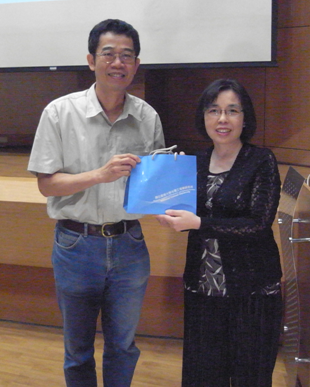 |
|
Su-Ling Liu, head of Taiwan human resources management center, Micron Taiwan (right), and GIPO professor Lung-Han Peng (left) |
|
|
|
4:30 pm, May 19 (Fri.), 2017 |
|
Speaker: |
Chien-Jung Kao, General Manager, Wistron NeWeb Corporation |
|
Topic:
|
What I Learned Rising From an Antenna Engineer to a Business Manager |
| |
Chien-Jung Kao,
general manager of Wistron NeWeb
Corporation, visited GIPO on May 19 (Fri.) and delivered the speech “What I Learned Rising From an Antenna Engineer to a Business Manager” at auditorium 101, Barry Lam Hall. His speech was splendid, informative, and Mr. Kao interacted very well with students. GIPO teachers and students participated with enthusiasm and benefitted a great deal. |
| |
|
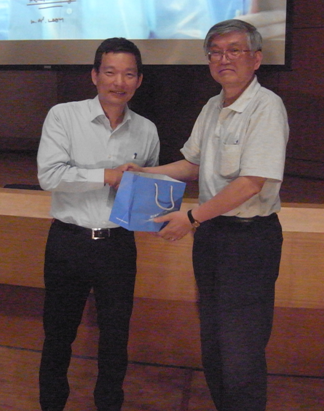 |
|
Chien-Jung Kao, the general manager of Wistron NeWeb Corporation (left), and GIPO professor Hung-Chun Chang (right) |
|
|
 |
|
 |
|
| |
|
|
 |
|
Hsiang-Chieh Lee
received his B.S. and M.S. degrees in civil engineering and electro-optical engineering from National Taiwan University in 2004 and 2006, respectively. He then attended the doctoral graduate program in the Department of Electrical Engineering and Computer Science (EECS) at Massachusetts Institute of Technology (MIT).
During his Ph.D. studies at MIT, his research focused on the biomedical applications of photonic and optoelectronic technologies. Through the collaboration with the physicians in the Department of Pathology at Beth Israel Deaconess Medical Center and Harvard Medical School (HMS), he performed several pilots studies on the use of optical coherence microscopy (OCM) technique for real-time imaging of the tissue specimens with a variety of pathologies. In addition, working with a team of gastroenterologists, nursing staff, and physician assistants in the Endoscopy Unit at the Veteran Affairs Boston Healthcare System and HMS, he investigated the clinical utility of endoscopic optical coherence tomography (OCT) and OCT angiography for the detection of early stage neoplasms in the human gastrointestinal (GI) tract and the predictive value of endoscopic OCT on the prognosis of patients who receive endoscopic treatments to eradicate GI neoplasms.
After receiving his Ph.D. degree in electrical engineering from MIT in 2017, he became an assistant professor at the Graduate Institute of Photonics and Optoelectronics at National Taiwan University. His current research interests include (1) early detection of pre-cancerous lesions with OCT and OCT angiography, (2) development of miniature optical imaging devices, and (3) minimally and non-invasive imaging techniques.
Outside of research and academics, he enjoys travel, photography, and movies.
As for the suggestions or recommendations to the graduate students, he believes that the nature of a career with growth opportunities is going to be diversified and requires multi-disciplinary expertises. Therefore, in addition to sharpening students’ understanding in the research fields they are working, he encourages students trying to cultivate interests in different areas as well in order to broaden their skill sets. It is more important to keep the journey of graduate study worthwhile than only chasing excellent scores on the course works. This promises to help students better define their positions and contribute to the communities whether in industry or academia settings after the graduation.
|
|
 |
|
 |
|
| |
|
 |
Photo-stability study of colloidal CdSe/ZnS quantum dots passivated in Al2O3 using atomic layer deposition
Professor Ming-Hua Mao’s laboratory
Graduate Institute of Photonics and
Optoelectronics, National Taiwan University
We report photo-stability enhancement of colloidal CdSe/ZnS quantum dots (QDs) passivated in Al2O3 thin film using the atomic layer deposition (ALD) technique. 62% of the original peak photoluminescence (PL) intensity remained after ALD. The photo-oxidation and photo-induced fluorescence enhancement (PFE) effects of both unpassivated and passivated QDs were studied under various conditions. Unpassivated QDs showed rapid PL degradation under high excitation due to strong photo-oxidation in air while the PL intensity of Al2O3 passivated QDs was found to remain stable. Our experimental results demonstrated that passivation of colloidal QDs by ALD is a promising method to well encapsulate QDs to prevent gas permeation and to enhance photo-stability. This is essential for the applications of colloidal QDs in light-emitting devices. This work has been published in J. Appl. Phys., vol.
120, pp. 083103, 2016.
|
 |
|
Fig. 1. PL spectra of unpassivated QDs (dotted line) and Al2O3 passivated QDs (solid line). |
|
 |
|
Fig. 2. Temporal evolution of PL intensities in air and in vacuum under CW excitation for unpassivated and passivated QDs at different power densities. |
Development of Extremely High External Quantum Efficiency Blue Organic Light emitting Devices
Professor Chung-Chih Wu
Graduate Institute of Photonics and
Optoelectronics, National Taiwan University
We have developed highly efficient blue organic light emitting diodes (OLEDs) based on highly efficient thermally activated delayed fluorescent (TADF) emitters. Photophysical studies indicate that TADF emitters can simultaneously possess nearly unitary (100%) photoluminescence quantum yields (PLQYs), and strongly anisotropically/horizontally oriented emitting dipoles (with horizontal dipole ratio of 83%) that can help boost optical out-coupling efficiencies of OLEDs. Baed on such advanced TADF emitters, extremely efficient blue OLEDs have been developed with ideal internal quantum efficiencies (IQE) of nealy 100% and very high external quantum efficiencies (EQE) of nearly 37% in conventional planar OLED structures (without using any internal/external optical out-coupling schemes), and even higher EQE of nearly 63% by adopting simple external optical out-coupling schemes. Such results are by far the highest EQE ever reported for blue TADF OLEDs and blue OLEDs of any kind, indicating their high potential for OLED applications.
|
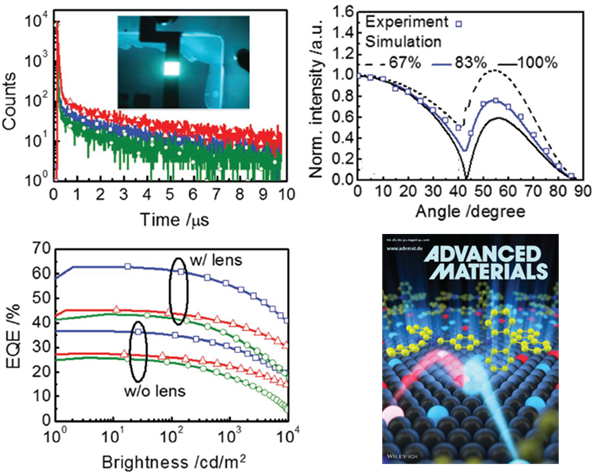 |
|
Fig. 1. Achieving very high external quantum efficiencies of blue OLEDs. |
High-Mobility Graphene Field Effect Transistors on Bare SiO2 Substrates
Professor Chih-I Wu
Graduate Institute of Photonics and
Optoelectronics, National Taiwan University
Here we use the chemical vapor deposition (CVD)-grown graphene on Cu foil and then transfer it via the polymer-free method to the SiO2 substrate like Fig.1.
The Dirac point of the large size GFET has a significant shift at about 82V (see figure 2a). Carrier mobility was extracted as shown in figure 2 and the electron and hole mobility are 1400 cm-2V-1s-1 and 250 cm-2V-1s-1, respectively. The hole mobility is close to the CVD graphene transferring on SiO2 substrates at 1.6K. This result implies that the large size GFET has too many defect and carbon cluster (see figure 1) at the channel, which will affect the electronic properties significantly.
Dirac point is around 28V and the shape of this curve is more symmetry than that shown in figure 2a. The carrier mobility of electron and hole is 5578cm-2V-1s-1 and 7734cm-2V-1s-1, respectively, and the mobility is much higher than the large size GFET. Fig.2b shows us that the small size GFET exhibits the Dirac point closer to the 0 point, because the defects or domain boundary will adsorb some particle on it such as H2O molecular to cause the p-type doping. The p-type doping will also affect the carrier mobility and affect the electron mobility especially.
In this study, we have demonstrated a new transfer technique for transferring graphene to prevent the PMMA residuals on the graphene surface. The Dirac point of small size GFET is at about 28V which shows the graphene intrinsic electronic properties. And the carrier mobility of small GFET are 5578cm-2V-1s-1 and 7734cm-2V-1s-1, respectively and this value is much higher than the data reported in the previous researches on bare SiO2 Substrates.
|
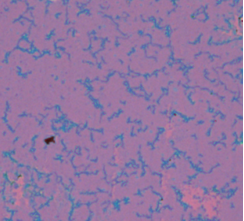 |
|
FIGURE 1. The OM image of CVD graphene transferred on a SiO2 substrate by polymer-free method.
|
|
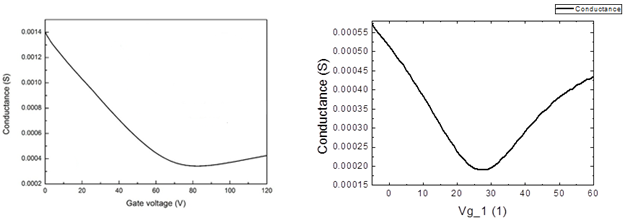 |
|
FIGURE 2a & 2b. The Vg versus σ of large and small size graphene FET, and the Dirac point is shift to 79V and 28V respectively. |
Variable focus microlens array with curved electrodes
Professor Guo-Dung J. Su's laboratory
Graduate Institute of Photonics and
Optoelectronics, National Taiwan University
A liquid crystal microlens array with a curved electrode is proposed and fabricated. The fabrication process consists of two parts: microlens array fabrication and liquid crystal cell assembly. Utilizing the hydrophilic confinement effect, an inkjet printer, and the replication process, a microlens array on a glass substrate is fabricated. PEDOT:PSS is spin-coated on the microlens array to form a curved electrode, and the microlens array is flattened by SU-8 photoresist and assembled with ITO glass. From interference patterns, the focusing power range is from −47.28 to −331 diopters under 10 V and it agrees well with theoretical calculation. This technology could be useful for optical zoom systems or focus-tunable lens applications.
|
 |
|
Fig. 1. The image performance of the liquid crystal microlens array at (a) V = 0 and (b) V = 10 |
|
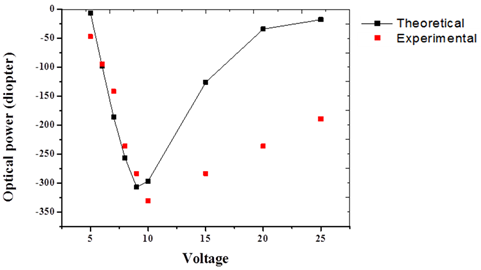 |
|
Fig. 2. Optical power at different voltages |
Blue organic light-emitting diode by exciplex sensitized triplet-triplet annihilation
Professor Jiun-Haw Lee
Graduate Institute of Photonics and
Optoelectronics, National Taiwan University
Energy up-conversion was achieved by exciplex sensitized triplet-triplet annihilation (ESTTA) process in an organic light-emitting diode (OLED) with blue emission. As shown in Fig. 1 (a), carrier recombines to form the exciplex, which serves as the low-bandgap sensitizer. Then, triplet exciton transfers the energy to the wide-bandgap emitter with triplet-triplet annihilation characteristic for blue-light generation. Fig. 1 (b) shows the emission spectra from this blue ESTTA-OLED under different voltages. Emission with peak at 430 nm (corresponding to 2.9 eV) was observed under 2.2 V driving. The driving voltage was lower than the photon energy which demonstrated the up-conversion process in this ESTTA-OLED.
|
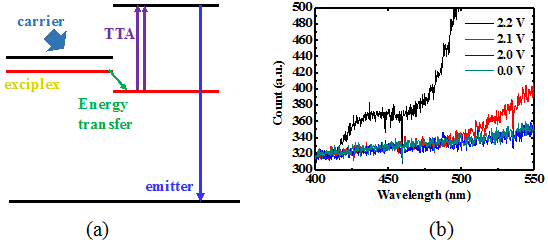 |
|
Fig. 1. (a) Schematic diagram of ESTTA process. (b) Emission spectra from the OLED under different driving voltages. |
|
|
|
 |
|
 |
|
| |
|
|
 |
|
 |
|
|
|